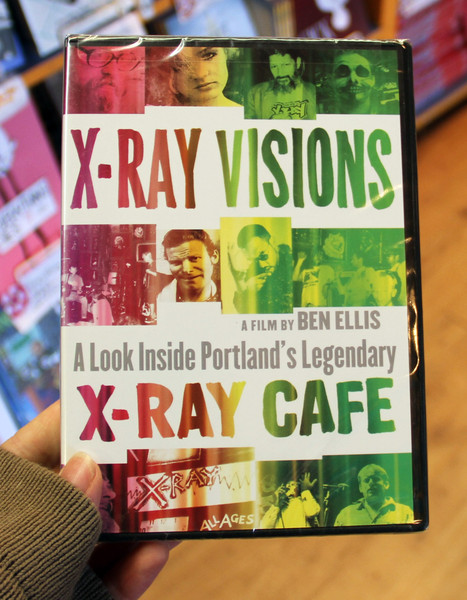
X-Ray Visions: A Look Inside Portland's Legendary X-Ray Cafe
by Benjamin Arthur Ellis Author
In October of 1990 the small space at 214 W. Burnside was still known as the UFO Café, owned by a thickly-accented Greek guy named Alkis. Unorthodox and adventurous in his musical tastes, Alkis hoped to increase his pizza sales by allowing a local band named The Kurtz Project to perform regularly and book other bands. Unbeknownst to the musicians and patrons, however, Alkis had been equally adventurous in his financial strategies and had stopped paying rent.
In the inevitable collapse that soon followed, Alkis vacated and two members of the house band, Benjamin Arthur Ellis and Tres Shannon, somehow emerged from the wreckage holding the lease. With no experience running a club, the pair set about transforming a hole-in-the-wall pizzeria into Portland's primary all-ages hole-in-the-wall music venue.
What was quickly christened the X-Ray Cafe soon featured blocked windows with cheerful signage handpainted above them. Underneath the building's gutted upper stories and rusted fire escape, the street-level exterior was whitewashed, and a mural was painted low along the sidewalk. The interior was furnished through a constant influx of thrifting scores, dumpster dives, and personal belongings. The walls were eventually hung with dozens of frustratingly memorable velvet paintings.
In hindsight, the timing of the X-Ray's birth was perfect. While grunge and alternative music were exploding in Seattle and a low-fi revolution was mounting in Olympia, the X-Ray, and nearby Satyricon, provided much-needed stages for smaller acts, and were crucial in establishing Portland as an important regional destination for touring bands. Both clubs also formed cradles for emerging Portland musicians, but it was the X-Ray that was far more fluid, encouraging, and open to the bizarre. Local bands Crackerbash, Pond, Hazel, Smegma, Poison Idea, Dead Moon, Hitting Birth, New Bad Things, Last Pariahs, Motorgoat (which became Quasi), and the Spinanes alternated with visits from Beat Happening, Unwound, Thinking Fellers Union Local 282, Hole, Sunny Day Real Estate, and Green Day.
Although it hosted an average of three or four bands a night, less than half of the X-Ray's operating hours were actually devoted to live music. Necessity and boredom fueled an endless succession of theme nights and "educational" afternoons. Sleepovers, Spanish lessons, drum and sewing circles, science and electronics lessons, and Q&A sessions about nothing in particular were regularly offered. Ellis and Shannon were open to virtually any community-minded event as long they didn't have to organize it.
Located near the geographic center of the city, the club's long hours and inclusive atmosphere attracted an amazing array of outcasts, street kids, and talkative eccentrics. Those familiar with the X-Ray invariably recall at least a few recurring characters who contributed their unique pathologies to the area's already rich pageantry. In time, some were given chores, and the chores eventually became unofficial jobs. Bands loading into the club for the first time would tread very carefully, unsure how to deal with these obnoxious patrons who seemed to move about with the casual confidence of long-time staff.
Frequent attendees were also a part of the X-Ray experience. Teenagers suspended in underage purgatory could be spotted in the crowd night after night. Like the "helpful" regulars, some of the most constant were eventually drafted into the staff. Familiar faces were such an important element of the X-Ray that when road trips were organized to Olympia and Eugene, a small army of regulars were enlisted to accompany the acts on the bill.
The jury-rigged environment, all-ages status, and enthusiastic crowd of frequently unstable regulars functioned like a filter. The X-Ray never felt "cool" like Satyricon felt cool. Hanging out solely to project an image was problematic at the X-Ray. Besides the fact that there was no bar and no alcohol, awkward (and often strongly scented) reality tended to intrude. It's hard to maintain aloof detachment when you've become the sole focus of a towering Elvis impersonator with a matted beard and dizzyingly thick lenses in his busted frames. The most studied, cultivated façade was no match for interpretive dancers flailing about on the floor two feet away. If you considered the X-Ray "hip," your definition of the word was necessarily broader than the fashionable, ironic, and smug.There was no sense of forced togetherness. No one was watching out of the corner of his or her eye to see whether you smiled or sulked. No one asked anything of you, except perhaps a moderate effort toward the physical safety of others. It was possible to walk through the door on an empty, late afternoon and curl up asleep against the far wall. Someone would greet you as you entered and then go back to sweeping the floors or fixing the sound system or painting the ceiling.
Before Portland had Reading Frenzy, the X-Ray served as a common distribution point for event flyers and the early output of the small-press and zine community. Its do-it-yourself attitude was a catalyst that trained sound technicians, inspired future business owners, and introduced organizers and activists to one another. Relationships both romantic and practical were initiated and still flourish.
It was also generally understood that simply by virtue of its presence and popularity, the X-Ray provided de facto services and protection for a number of homeless, at-risk youths. And at a time when national needle-exchange programs were struggling to prove their worth, the X-Ray stepped forward and became the first satellite exchange in Portland.
The X-Ray lasted until August of 1994, when Ben and Tres retired it voluntarily in the face of an uncertain future filled with certain debts. In the end, fundraisers and round-the-clock marathon shows weren't enough to balance mounting bills and exhaustion. After one last legendary, exultant, and emotional night, the X-Ray closed. This is as close to what ever could be the whole story.
You must log in to comment.



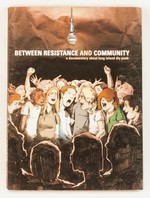
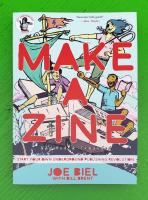
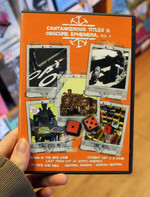
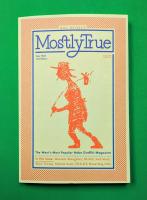

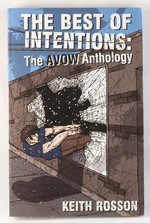
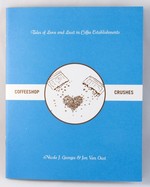

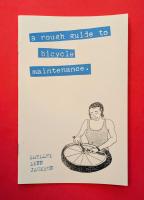
Comments & Reviews
“They convince you that X-Ray Café seriously was not just any club. The true strangeness, genuine sense of the avant garde, actual commitment to social causes, true ‘alternative’ happenings, and complete lack of business sense made this a remarkable place and this DIY video is a fitting eulogy.”
I don't listen to the radio much, but today I turned on 94.7 while stuck in traffic. The radio DJ was the guy from Big Daddy Meat Straw. I think about that every time I hear his voice on the radio. I say BDMS in concert a hand full of times when I was 13 and 14. I'm 29 now. lol. I thought "you know what? I'm going to google them when I get home" It led me to this website. I didn't realize at such a young age what I was experiencing at X-Ray. I knew it was cool and I hung out with an older crowd that all hung out there. But I didn't realize that place would be such history. One of the first times I smoked pot in pubic was on the mattress on the top top weird part of the club. Not sure how to explain that. anyway, thought I would share that thought.
[This] obscure, nostalgia [punk] documentary [is done] the correct way; for those who were there and have fond or not so fond memories of the place.
Too often films about scenes feel very snooty and exclusionary, but though it is geared to a specific audience, this film’s focus is handled in such a way that even those of us who weren’t there feel almost a sense of inclusion, leaving us wishing we’d been there for the fun, but not making us feel like assholes ‘cause we weren’t. Not a bad way to spend an hour, by any stretch.
Accepting of almost all cultural expression or character type that wasn't mean-spirited, the X-Ray championed a kind of inspired amateurism and a participatory environment that's unlikely to be equaled for audacity or fun. In the words of one former regular, 'the X-Ray was the cat's potato.' And so is this film.
I'm giving X-Ray Visions four out of four cigars, because it' s well made, the story is great and it really makes you wish that places like this weren't quite as rare as they are! It's a great little movie and you're bound to enjoy it!
The film never attempts the impossible and pointless task of overall analysis. There is no agenda beyond acknowledging that something remarkable happened in and around the X-Ray during the early '90s.
X-Ray Visions is very much a Portland film. . . it gives you an insight into a scene that not a lot of people were actually in but many people heard about.
Yeah, I saw it.
I really wish I was around to experience some of this. It's probably half the reason why the current crop of bizarro business owners in that city do what they do. They were probably all raised on X-Ray. The only comparison I can think of is like a giant version of Voodoo Donuts minus the donuts and with more music. Investigate it for yourself to get a little essential piece of Portland's always interesting history.
X-Ray Visions does the obscure, nostalgia documentary the correct way ... There was an open attitude of allowing anyone the shot at stardom, so many creative types played at the club. Bigger and soon to be really big bands played there too. There was a clubhouse feel. This documentary captures that feeling.